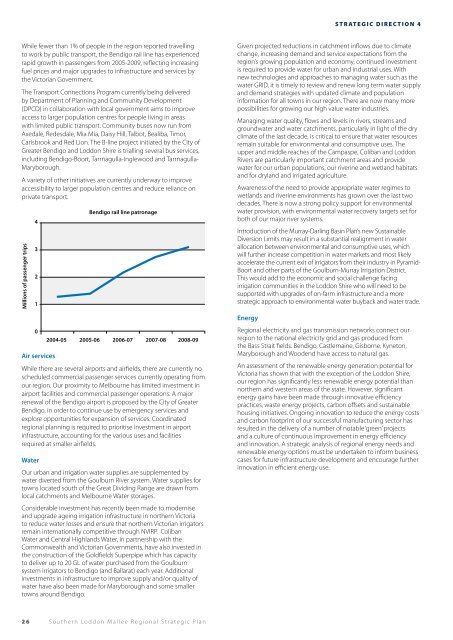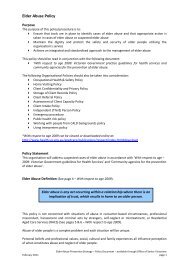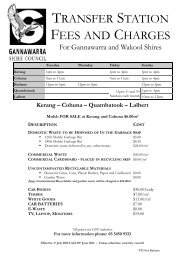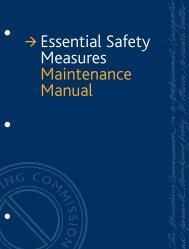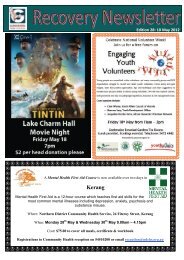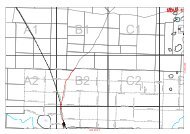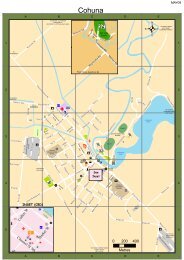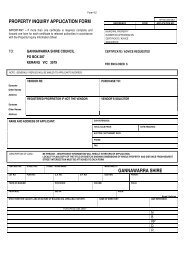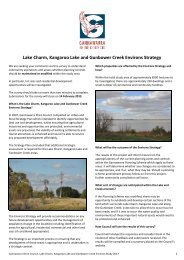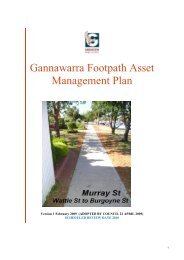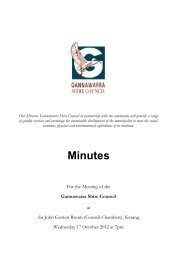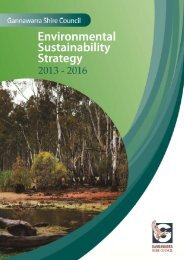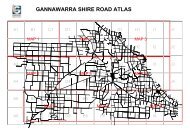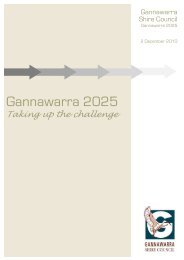Southern Loddon Mallee Regional Strategic Plan 1 - Macedon ...
Southern Loddon Mallee Regional Strategic Plan 1 - Macedon ...
Southern Loddon Mallee Regional Strategic Plan 1 - Macedon ...
Create successful ePaper yourself
Turn your PDF publications into a flip-book with our unique Google optimized e-Paper software.
While fewer than 1% of people in the region reported travelling<br />
to work by public transport, the Bendigo rail line has experienced<br />
rapid growth in passengers from 2005-2009, reflecting increasing<br />
fuel prices and major upgrades to infrastructure and services by<br />
the Victorian Government.<br />
The Transport Connections Program currently being delivered<br />
by Department of <strong>Plan</strong>ning and Community Development<br />
(DPCD) in collaboration with local government aims to improve<br />
access to larger population centres for people living in areas<br />
with limited public transport. Community buses now run from<br />
Axedale, Redesdale, Mia Mia, Daisy Hill, Talbot, Bealiba, Timor,<br />
Carisbrook and Red Lion. The B-line project initiated by the City of<br />
Greater Bendigo and <strong>Loddon</strong> Shire is trialling several bus services,<br />
including Bendigo-Boort, Tarrnagulla-Inglewood and Tarrnagulla-<br />
Maryborough.<br />
A variety of other initiatives are currently underway to improve<br />
accessibility to larger population centres and reduce reliance on<br />
private transport.<br />
Millions of passenger trips<br />
4<br />
3<br />
2<br />
1<br />
0<br />
2004-05<br />
Bendigo rail line patronage<br />
2005-06 2006-07 2007-08 2008-09<br />
Air services<br />
While there are several airports and airfields, there are currently no<br />
scheduled commercial passenger services currently operating from<br />
our region. Our proximity to Melbourne has limited investment in<br />
airport facilities and commercial passenger operations. A major<br />
renewal of the Bendigo airport is proposed by the City of Greater<br />
Bendigo, in order to continue use by emergency services and<br />
explore opportunities for expansion of services. Coordinated<br />
regional planning is required to prioritise investment in airport<br />
infrastructure, accounting for the various uses and facilities<br />
required at smaller airfields.<br />
Water<br />
Our urban and irrigation water supplies are supplemented by<br />
water diverted from the Goulburn River system. Water supplies for<br />
towns located south of the Great Dividing Range are drawn from<br />
local catchments and Melbourne Water storages.<br />
Considerable investment has recently been made to modernise<br />
and upgrade ageing irrigation infrastructure in northern Victoria<br />
to reduce water losses and ensure that northern Victorian irrigators<br />
remain internationally competitive through NVIRP. Coliban<br />
Water and Central Highlands Water, in partnership with the<br />
Commonwealth and Victorian Governments, have also invested in<br />
the construction of the Goldfields Superpipe which has capacity<br />
to deliver up to 20 GL of water purchased from the Goulburn<br />
system irrigators to Bendigo (and Ballarat) each year. Additional<br />
investments in infrastructure to improve supply and/or quality of<br />
water have also been made for Maryborough and some smaller<br />
towns around Bendigo.<br />
26 <strong>Southern</strong> <strong>Loddon</strong> <strong>Mallee</strong> <strong>Regional</strong> <strong>Strategic</strong> <strong>Plan</strong><br />
STRaTegIC DIReCTION 4<br />
Given projected reductions in catchment inflows due to climate<br />
change, increasing demand and service expectations from the<br />
region’s growing population and economy, continued investment<br />
is required to provide water for urban and industrial uses. With<br />
new technologies and approaches to managing water such as the<br />
water GRID, it is timely to review and renew long term water supply<br />
and demand strategies with updated climate and population<br />
information for all towns in our region. There are now many more<br />
possibilities for growing our high value water industries.<br />
Managing water quality, flows and levels in rivers, streams and<br />
groundwater and water catchments, particularly in light of the dry<br />
climate of the last decade, is critical to ensure that water resources<br />
remain suitable for environmental and consumptive uses. The<br />
upper and middle reaches of the Campaspe, Coliban and <strong>Loddon</strong><br />
Rivers are particularly important catchment areas and provide<br />
water for our urban populations, our riverine and wetland habitats<br />
and for dryland and irrigated agriculture.<br />
Awareness of the need to provide appropriate water regimes to<br />
wetlands and riverine environments has grown over the last two<br />
decades. There is now a strong policy support for environmental<br />
water provision, with environmental water recovery targets set for<br />
both of our major river systems.<br />
Introduction of the Murray-Darling Basin <strong>Plan</strong>’s new Sustainable<br />
Diversion Limits may result in a substantial realignment in water<br />
allocation between environmental and consumptive uses, which<br />
will further increase competition in water markets and most likely<br />
accelerate the current exit of irrigators from their industry in Pyramid-<br />
Boort and other parts of the Goulburn-Murray Irrigation District.<br />
This would add to the economic and social challenge facing<br />
irrigation communities in the <strong>Loddon</strong> Shire who will need to be<br />
supported with upgrades of on-farm infrastructure and a more<br />
strategic approach to environmental water buyback and water trade.<br />
Energy<br />
<strong>Regional</strong> electricity and gas transmission networks connect our<br />
region to the national electricity grid and gas produced from<br />
the Bass Strait fields. Bendigo, Castlemaine, Gisborne, Kyneton,<br />
Maryborough and Woodend have access to natural gas.<br />
An assessment of the renewable energy generation potential for<br />
Victoria has shown that with the exception of the <strong>Loddon</strong> Shire,<br />
our region has significantly less renewable energy potential than<br />
northern and western areas of the state. However, significant<br />
energy gains have been made through innovative efficiency<br />
practices, waste energy projects, carbon offsets and sustainable<br />
housing initiatives. Ongoing innovation to reduce the energy costs<br />
and carbon footprint of our successful manufacturing sector has<br />
resulted in the delivery of a number of notable ‘green’ projects<br />
and a culture of continuous improvement in energy efficiency<br />
and innovation. A strategic analysis of regional energy needs and<br />
renewable energy options must be undertaken to inform business<br />
cases for future infrastructure development and encourage further<br />
innovation in efficient energy use.


